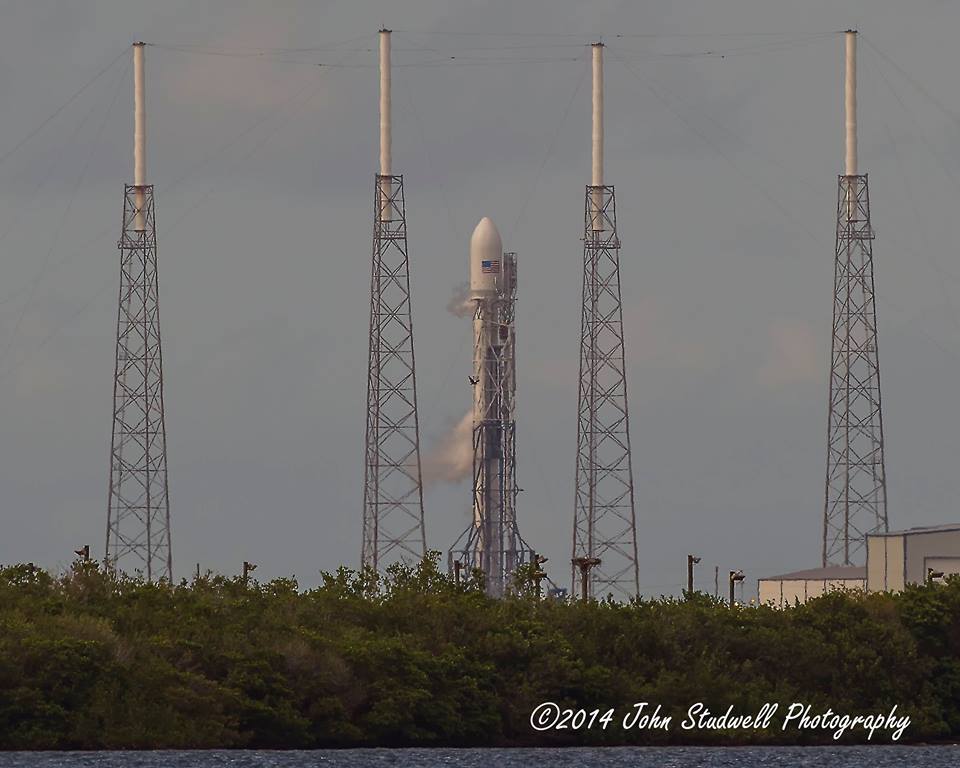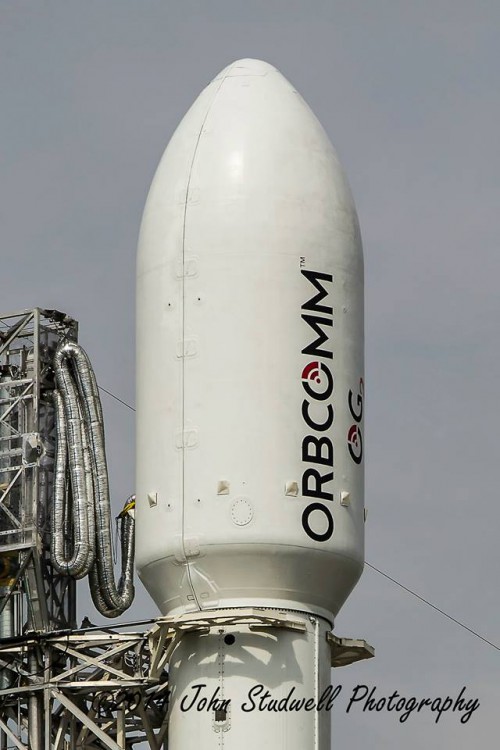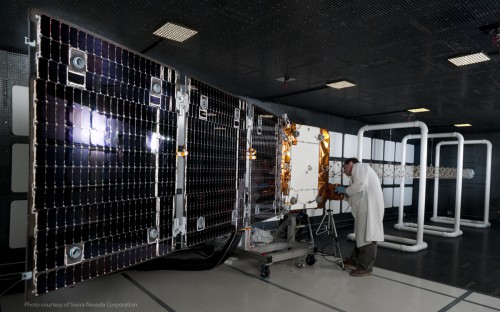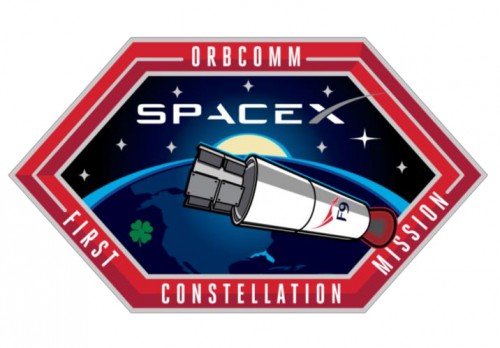
After many delays—including yesterday’s down-to-the-wire launch attempt, scrubbed in its final minutes, following an anomalous “pressure decrease” in the second stage of the Falcon 9 v1.1 booster—SpaceX fell foul Cape Canaveral’s dynamic weather on Saturday evening as yet another effort to get six Orbcomm Generation-2 (OG-2) satellites into orbit came to nothing. Liftoff was scheduled to occur at 5:46 p.m. from Space Launch Complex (SLC)-40, at the start of a 53-minute “window.” However, bearing unpleasant reminders of yesterday, the countdown clock was recycled to track a liftoff at the end of the window, and ultimately when the weather refused to co-operate the attempt was scrubbed. For many viewers, the disappointment was intensified by the fact that SpaceX had controversially announced that it had no intention of providing a live webcast of the launch.
Originally scheduled to fly in May, the mission was repeatedly postponed, due to problems with the Falcon 9 v1.1 and, more recently, with one of the OG-2 satellites. With the co-operation of the Eastern Range, a primary launch opportunity was finalized for Friday, 20 June, with a backup opportunity Saturday, 21 June. Yesterday, the weather outlook seemed pessimistic, with just a 30-percent likelihood of acceptable meteorological conditions, due to a low-pressure zone which threatened the Cape with cumulus clouds, thick clouds, anvil clouds, and a heightened risk of lightning. Nevertheless, SpaceX and Orbcomm, Inc., rolled the Falcon 9 out to SLC-40 and the vehicle was put crisply through its propellant-loading protocols.
As Friday wore on, the weather situation gradually improved to 40-percent favorable, tracking a liftoff at 6:08 p.m. EDT, at the start of a 53-minute window. However, at 5:53 p.m., just a couple of minutes before the standard polling of all stations for their “Go/No-Go” status at T-13 minutes, and the subsequent initiation of the “Terminal Countdown” at T-10 minutes, the clock abruptly stopped. It was recycled to track a revised T-0 at 7:01 p.m., right at the end of the window, in order to allow SpaceX engineers to take a closer look at a potential fuel leak. Less than an hour later, at 6:35 p.m., it was noted that a “pressure decrease” had been observed with the Falcon’s second stage, although it remained unclear if the problem lay with the vehicle itself or the ground support equipment.

Ironically, the weather—which had seesawed from “Red” (“No-Go”) to “Green” (“Go”) and back again several times during the day—remained acceptable for launch, and the OG-2 satellites were transitioned to internal power, in the hope that the second stage problem might be resolved in time for T-0. At 6:48 p.m., the standard poll of all stations was conducted by SpaceX Flight Director Brian Childers, and the Terminal Countdown got underway three minutes later. Now running on the “autosequencer,” the nine Merlin-1D engines of the Falcon’s first stage underwent a “chill-down” procedure to thermally condition them ahead of the ignition sequence. Unfortunately, a launch was not on the cards. Sixty seconds later, the words “Hold, Hold, Hold” were called by the Second Stage team over the flight loop and the countdown was halted. With no further “wiggle room” in the window, an abort was commanded at 6:58 p.m. EDT and efforts began to “safe” the vehicle.
“A good pressurization of all the systems is a critical requirement for launch,” explained Spaceflight101 late Friday, “warranting a thorough analysis before an issue of this type can be cleared. Teams decided to press into the terminal countdown and go deep into the count while engineering continued the assessment to be ready to launch if clearance could be obtained. However, about 7 minutes ahead of the T-0 time, the second stage team called a Terminal Countdown Abort and, per the procedure, the countdown was stopped to transition the Falcon 9 to a safe configuration.”
With a predicted 60-percent likelihood of acceptable weather Saturday, 21 June, it remained unclear for more than 12 hours whether SpaceX was positioning itself for a second attempt on its backup day. Early on Saturday afternoon, Orbcomm announced that a decision had been made to attempt a launch at 5:46 p.m. EDT, at the start of another 53-minute window. The deteriorating weather conditions were already posing a threat to launch, with the 45th Space Wing tweeting the presence of thunderstorms in the vicinity of the Cape, and the countdown was recycled to target a revised T-0 time of 6:39 p.m., right at the end of today’s window.
The pessimism was not helped by the revelation that SpaceX would not be offering live coverage of the launch, in the form of a webcast. This news was met with dismay by individual members of the space media and surely will harm SpaceX’s reputation, particularly in the aftermath of its ugly criticisms of United Launch Alliance (ULA) in recent months with regard to military satellite monopolies. Many space enthusiasts and professionals were united in the belief that SpaceX owed it to the U.S. public to conduct its business in the open. “In honor of @SpaceX PR move to cancel launch webcast, we’re canceling our launch coverage of today’s Falcon 9 launch attempt from SLC-40,” tweeted InsideKSC, whilst SpaceRef lamented that it “Looks like media who want to cover today’s #SpaceX launch & aren’t at the Cape in person are out of luck.” Stephen Clark added a personal message to SpaceX and Musk himself: “Not webcasting launches hurts your corporate interests and the public interest. Take us along for the ride.” NASASpaceflight.com’s Chris Bergin noted, tongue-in-cheek, that “We’ll need to draw pictures,” whilst Robert Pearlman of CollectSpace.com pointed out that “Webcasting launches is important to maintaining U.S. history of conducting space efforts in the open. Please reconsider.” Yet it was arguably Spaceflight Now’s tweet which underscored the significance of SpaceX’s decision, “the first from Cape without a countdown provided to the press & public since end of Cold War.” Multiple enquiries from AmericaSpace were ignored by Musk’s company, as has unfortunately become the norm with media requests to SpaceX.

Notwithstanding the pessimism, and the cloudy skies, conditions began to clear later in the countdown. At 6:10 p.m., with a little over 25 minutes to go before the closure of Saturday’s window, the 45th Space Wing tweeted the welcome news that it “stands ready to support the Orbcomm OG-2 mission.” However, it was not to be. Shortly before the countdown was due to reach the polling point at T-13 minutes, a scrub was announced. With SpaceX having maintained a near-total silence in its social media outlets, and even Orbcomm having provided no updates, save the opening of Saturday’s launch window, it was left to the 45th Space Wing to report the news of the delay. “Rescheduled information will be made once it becomes available,” read a tweet from the 45th.
When they do eventually make it into space, the six OG-2 satellites will enter a circular orbit of 460 x 460 miles (750 x 750 km), inclined 52 degrees to the equator. They will remain in service for at least five years and provide two-way messaging services for global customers. Following a failed inaugural OG-2 launch in October 2012, the six satellites were all built by Sierra Nevada Corp. (SNC). Another 11 OG-2 satellites—which are currently undergoing final processing at SNC—are expected to fly aboard another Falcon 9 v1.1 later this year. Orbcomm announced in May 2008 that SNC would build a total of 18 satellites for a fee of $117 million, with an option for up to 30 others. A few weeks later, Orbcomm selected Argon ST, a subsidiary of Boeing, to develop advanced communications payloads to increase subscriber capacity by up to 12 times over earlier satellites, as well as transmitting data at higher speeds and quantities. Designed with Automatic Identification System (AIS), it is expected that the OG-2 network will be marketed by Orbcomm to U.S. and international coast guards and government agencies, as well as private security and logistics companies.
At the time of writing, 45 Orbcomm satellites have been delivered into orbit since July 1991, aboard a wide range of vehicles, including Europe’s Ariane 4, the air-launched Pegasus booster, Orbital Sciences Corp.’s Taurus, China’s Long March 4B, India’s Polar Satellite Launch Vehicle (PSLV), and Russia’s Cosmos-3M. Initial “Concept Demonstration Satellites” led to the OG-1 network and a replenishment series of “Quick Launch” missions, with the OG-2 series intended to supplement and eventually replace the first generation. “Due to their high efficiency and modular design, these satellites have substantially more capacity to service a larger number of subscribers, thus making the network more efficient with few satellites than the OG-1 satellites that are currently in orbit,” explained Pat Remias, SNC’s Space Systems senior director of programs. “SNC has established a satellite production line in our Louisville facility to integrate and test each vehicle rapidly, with up to six satellites processing simultaneously.”

By 2009, Orbcomm had settled on SpaceX’s Falcon 9 as its vehicle of choice, with the inaugural launches originally anticipated the following year, but postponed several times due to delays and schedule slips. The first OG-2 “prototype” satellite was launched in October 2012, flying “piggyback” alongside SpaceX’s CRS-1 Dragon. However, an upper stage engine shortfall caused it to be inserted into a low orbit of just 125 x 200 miles (200 x 320 km), instead of the planned 220 x 470 miles (350 x 750 km). Despite the successful deployment of the satellite from the final stage of the Falcon 9, it quickly became clear that the low orbit was “unworkable” and the first OG-2 re-entered the atmosphere to destruction a few days later.
In preparation for the next batch of OG-2 launches, four satellites arrived at Cape Canaveral Air Force Station from SNC shortly after noon EDT on 21 April 2014, followed by two others on the 26th. Each satellite weighs 380 pounds (172 kg) and, when fully deployed in orbit, will measure 42.7 feet (13 meters) x 3.3 feet (1 meter) x 1.6 feet (0.5 meters) and generate about 400 watts of electrical power. The satellites underwent extensive checks and fueling of their hydrazine attitude-control systems, and on 6 May SpaceX performed a Flight Readiness Review and confirmed its status as “Go” for launch on the 10th. The payload stack, containing the six satellites on their Expendable Launch Vehicle Secondary Payload Adaptor (ESPA) “ring,” was subsequently encapsulated within the bulbous Falcon 9 v1.1 fairing and attached to the rocket.
Rollout to SLC-40 occurred early Thursday, 8 May, after which SpaceX intended to conduct a standard static “hot-fire” test of the nine Merlin-1D first-stage engines. However, a considerable helium leak on the first stage caused the hot fire to be postponed by 24 hours, then scrubbed indefinitely. “Today’s attempt to perform the static firing test was stopped while the rocket was being fueled,” explained Orbcomm on the 9th. “Both the OG-2 satellites and the rocket are in safe condition and will be rotated horizontal and rolled back into the integration facility. This will prevent us from launching this weekend.” Hardware from the first stage was removed and returned to SpaceX’s facility in Hawthorne, Calif., for inspections and verifications to ensure that the problem did not represent a systemic failure and a threat to future missions.
On 19 May, a revised target of 11 June was announced and it was noted that the Orbcomm and SNC processing teams would arrive at the Cape about a week before launch to participate in the lengthy process of re-encapsulating the OG-2 satellites back into their adaptor. By the end of May, the launch had moved a further 24 hours to the right and on 10 June Orbcomm revealed a new target of No Earlier Than the 15th. “During final integration on one of the OG-2 spacecraft,” it was explained, “we encountered a minor issue resulting in a few extra days of delay to perform precautionary steps to ensure there are no operational concerns with the satellite.” In the meantime, last Friday, SpaceX performed a successful static hot-fire test, but it was feared that upcoming maintenance of Eastern Range tracking assets might result in a further delay until July. However, after “finalizing the launch schedule with the Range at the Cape”—a new date of 20 June was issued. Both it and today’s launch attempt were frustrated by technical and weather-related issues.
Want to keep up-to-date with all things space? Be sure to “Like” AmericaSpace on Facebook and follow us on Twitter: @AmericaSpace
Missions » Commercial Space » ORBCOMM » SpaceX OG2 M1 »



Good article, the more pressure put on SpaceX the better for this decision. Until they can exceed the launch rate of ULA they do not get to use the word “routine” for their launches. I am a huge HUGE SpaceX fan but they made it a little difficult today.
“Multiple enquiries from AmericaSpace were ignored by Musk’s company, as has unfortunately become the norm with media requests to SpaceX.”
Curious given how positive the general press coverage of SpaceX has been.
Regardless of this situation, the decision to give the commercial crew contract to SpaceX is a foregone conclusion. Musk LOVES his designation of the “Number 1 Disruptor” by CNBC, and he has NASA, the Air Force, and Congress (with the possible exception of Sen. “Stonewall” Shelby) running scared. They wouldn’t DARE stand up to Musk, his lawyers,and his minions, so those 215 Boeing workers who will be laid off if the CST-100 is not chosen had better start reviewing their resumes.
Joe,
The press coverage of SpaceX has indeed been positive, in light of their missions, vehicles and achievements. Indeed, as you will note from many AmericaSpace articles about SpaceX, we have written generally positively about their achievements. Writing “positively” or “negatively” about missions is not the issue here, although it is the position of this site that all sides should be reported equally. We have written with equal concern in the aftermath of problems involving other launch providers. As you will undoubtedly note from many Twitter comments and the general media response yesterday, the positivity of the media took a distinctly negative turn. Our site’s point is simply that AmericaSpace has made multiple requests for information which have been unanswered.
Many thanks for your comment.
Regards,
Ben
Ben,
I agree with your assessment of the fairness of America Space coverage and if I have not said it before I appreciate it. That evenhandedness is in fact the main reason I use this site as a primary information source for space related news. I have confidence that what I am getting is as accurate as the available information will allow without any editorializing (that can be left to the posters in the comments section – including myself).
I have to admit I do not keep up with Twitter and had not checked on the reporting on the most recent launch delay. Based on your comment I checked and the reporting on the lack of video feed for the attempted launch did indeed take a negative turn, especially among the sources specializing in space reporting but among the more general press (like Reuters) as well.
Thanks again,
Joe
It seems funny that the Russians launch if funky weather with their Soyuz launcher and continuously rack up spaceflight after spaceflight! They have launched in snowstorms for pity sakes. I remember one of our Moon rockets was hit by lightening and flipped all the on board breakers. Now Im not saying launch in a storm, but it just makes me wonder! SpaceX needs to webcast their launches. Even when ULA makes secret military launches, they are presented!
Well press packages and Webcasts cost money too….I suspect that SpaceX is having a bit of cash flow issues…But I understand that No One in the Government Run Launch Operations knows what that means…Really I think everybody would be better suited if they compared the company to Microsoft and not NASA…Clearly everything that SpaceX is doing is the “BETA” version as they are building the first reusable system…I do agree SpaceX should not be pursuing Military launch contracts….And as soon as they finish the current ISS contract should NOT continue that contract as well. Once they have completely demonstrated reuse capability…Demand for their systems will increase beyond all expectations…Only by NOT having government launch work will they have the resources to fulfill the private sector demand..
In reply to Tracy the Troll, I see no reason to take away Cargo or Crew opportunities from SpaceX. They have done a great job on those so far. The big problem is that they are terrible at keeping launch schedules. More realistically the DoD should get them certified but state that they cannot bid or launch until they can also demonstrate some level of schedule adherence.
It seems that they miss more chances to launch when the delay “to make sure everything is perfect”. With each self imposed delay, they fall prone to some accident with the range or competitors rocket then puts them further off. Many of these delays, I suspect, stem from dealing with changes made to the design of the rocket such as adding the landing legs, etc. I love these advancements, which must have the opportunity to fly, but the research should not be allowed to effect customer launch schedules. .Ripen the technology more before test. Get Launch cadence up.
I believe the Crew and Cargo opportunities of the private sector will be the only contracts that SpaceX will be able to fulfill on a regular basis. The scrutiny of government launch work is debilitating as there are too many stake holders that must be appeased by those who dine off of the government trough…And this requires a large overhead to obligate them…. It does not matter what the industry is..Government Does Not Work Like The Private Sector …never …ever…Until Machines take over running the government there will be no real efficiency in operations or decisions….This will become very clear after the first time SpaceX returns the first stage back to land propulsefully…